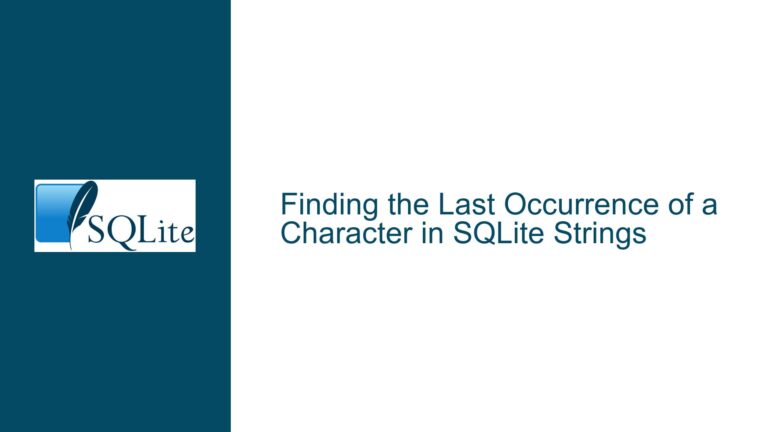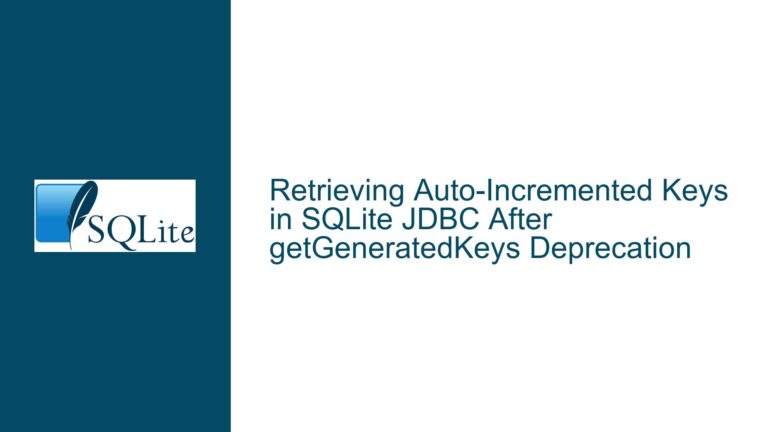Filtering SQLite Column for Multiple Patterns Efficiently
Understanding the Problem: Filtering a Column for Multiple Patterns
When working with SQLite, one common task is filtering a column based on multiple patterns. This often arises when dealing with columns that contain composite values, such as product codes or identifiers that combine multiple pieces of information into a single string. In the case of the partner_sku column, the values are structured in a way that the first part of the string (before a dash) represents a family of items, and the latter part represents a variant. The goal is to filter rows based on the family part of the partner_sku.
The initial approach was to use multiple LIKE clauses in the WHERE statement, such as:
SELECT partner_sku FROM ctl WHERE partner_sku LIKE 'A1012%' OR partner_sku LIKE 'A207%' OR partner_sku LIKE 'KH108%';
While this works for a small number of patterns, it becomes unwieldy and inefficient as the number of patterns grows. The query becomes difficult to maintain, and performance can degrade, especially with large datasets. This raises the question: How can we filter a column for multiple patterns in a more efficient and maintainable way?
Possible Causes of Inefficiency and Maintenance Challenges
The inefficiency and maintenance challenges in the initial approach stem from several factors:
Repetitive Code: Using multiple
LIKEclauses results in repetitive code. Each new pattern requires an additionalORcondition, making the query longer and harder to read. This also increases the risk of errors when modifying the query.Performance Issues: The
LIKEoperator, especially with wildcards, can be slow because it often requires a full table scan. When multipleLIKEconditions are combined withOR, the database engine may need to scan the table multiple times, leading to poor performance, particularly with large datasets.Lack of Normalization: The
partner_skucolumn contains composite data, with the family and variant information combined into a single string. This violates the principles of database normalization, which advocate for storing atomic (indivisible) data in separate columns. As a result, filtering based on the family part of thepartner_skurequires string manipulation, which is less efficient than filtering on a dedicated column.Scalability Concerns: As the number of patterns grows, the query becomes more complex and harder to manage. This is not scalable, especially when the patterns are dynamic or derived from another data source.
Troubleshooting Steps, Solutions & Fixes
To address these issues, we can explore several solutions, each with its own advantages and trade-offs. The goal is to make the query more efficient, maintainable, and scalable.
1. Using SUBSTR and INSTR Functions for Pattern Extraction
One approach is to extract the family part of the partner_sku using SQLite’s SUBSTR and INSTR functions. This allows us to filter based on the extracted family part, which can then be compared using the IN clause. Here’s how it works:
SELECT partner_sku
FROM ctl
WHERE SUBSTR(partner_sku, 1, INSTR(partner_sku, '-') - 1) IN ('A1012', 'A207', 'KH108');
In this query:
INSTR(partner_sku, '-')finds the position of the first dash in thepartner_sku.SUBSTR(partner_sku, 1, INSTR(partner_sku, '-') - 1)extracts the substring from the start ofpartner_skuup to (but not including) the dash.- The
INclause checks if the extracted substring matches any of the specified family codes.
This approach eliminates the need for multiple LIKE clauses and makes the query more concise. However, it still requires string manipulation for each row, which can be slow for large datasets.
2. Creating an Index on the Extracted Pattern
To improve performance, we can create an index on the extracted family part of the partner_sku. This allows SQLite to quickly locate rows that match the specified family codes without scanning the entire table. Here’s how to create the index:
CREATE INDEX ctl_idx ON ctl (SUBSTR(partner_sku, 1, INSTR(partner_sku, '-') - 1));
With this index in place, the previous query will use the index to efficiently find the matching rows:
SELECT partner_sku
FROM ctl
WHERE SUBSTR(partner_sku, 1, INSTR(partner_sku, '-') - 1) IN ('A1012', 'A207', 'KH108');
This approach significantly improves performance, especially for large tables. However, it requires maintaining an index, which can increase the storage requirements and slightly slow down data modifications (inserts, updates, deletes).
3. Adding a Virtual Column for the Family Part
Another approach is to add a virtual column to the table that stores the family part of the partner_sku. Virtual columns are computed columns that are not stored on disk but are calculated on the fly when queried. Here’s how to add a virtual column:
ALTER TABLE ctl ADD COLUMN partner_sku_prefix TEXT AS (SUBSTR(partner_sku, 1, INSTR(partner_sku, '-') - 1));
Once the virtual column is added, we can create an index on it to improve query performance:
CREATE INDEX ctl_idx ON ctl(partner_sku_prefix);
Now, we can filter based on the virtual column:
SELECT partner_sku
FROM ctl
WHERE partner_sku_prefix IN ('A1012', 'A207', 'KH108');
This approach combines the benefits of the previous solutions: it eliminates the need for repetitive LIKE clauses, avoids the overhead of string manipulation in the query, and leverages indexing for fast lookups. Additionally, it makes the query more readable and maintainable.
4. Normalizing the Database Schema
The most robust solution is to normalize the database schema by splitting the partner_sku into separate columns for the family and variant parts. This involves creating a new table to store the family codes and modifying the original table to reference this new table. Here’s how to do it:
- Create a New Table for Family Codes:
CREATE TABLE item_families (
family_code TEXT PRIMARY KEY
);
- Populate the New Table with Family Codes:
INSERT INTO item_families (family_code)
SELECT DISTINCT SUBSTR(partner_sku, 1, INSTR(partner_sku, '-') - 1)
FROM ctl;
- Modify the Original Table to Reference the New Table:
ALTER TABLE ctl ADD COLUMN family_code TEXT;
UPDATE ctl
SET family_code = SUBSTR(partner_sku, 1, INSTR(partner_sku, '-') - 1);
- Create an Index on the New Column:
CREATE INDEX ctl_family_idx ON ctl(family_code);
- Query Using the Normalized Schema:
SELECT ctl.partner_sku
FROM ctl
JOIN item_families ON ctl.family_code = item_families.family_code
WHERE item_families.family_code IN ('A1012', 'A207', 'KH108');
This approach adheres to the principles of database normalization, making the schema more flexible and easier to maintain. It also improves query performance by allowing efficient joins and indexing. However, it requires more upfront work to modify the schema and migrate the data.
5. Using a Temporary Table for Ad-Hoc Queries
If modifying the schema is not feasible, another option is to use a temporary table to store the family codes for ad-hoc queries. This approach is useful when the family codes are dynamic or derived from another data source. Here’s how to do it:
- Create a Temporary Table:
CREATE TEMP TABLE temp_families AS
SELECT 'A1012' AS family_code
UNION ALL
SELECT 'A207'
UNION ALL
SELECT 'KH108';
- Query Using the Temporary Table:
SELECT ctl.partner_sku
FROM ctl
JOIN temp_families ON SUBSTR(ctl.partner_sku, 1, INSTR(ctl.partner_sku, '-') - 1) = temp_families.family_code;
This approach is flexible and does not require permanent changes to the schema. However, it is less efficient than the previous solutions because it involves joining with a temporary table and performing string manipulation for each row.
Conclusion
Filtering a column for multiple patterns in SQLite can be challenging, especially when dealing with composite values and large datasets. The initial approach of using multiple LIKE clauses is simple but inefficient and hard to maintain. By extracting the relevant part of the string, creating indexes, adding virtual columns, or normalizing the schema, we can significantly improve the efficiency and maintainability of the query. Each solution has its own trade-offs, and the best approach depends on the specific requirements and constraints of the project.






